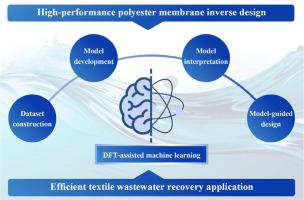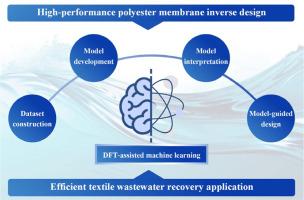DFT-assisted machine learning for polyester membrane design in textile wastewater recovery applications
IF 12.4
1区 环境科学与生态学
Q1 ENGINEERING, ENVIRONMENTAL
引用次数: 0
Abstract
Resource recovery from textile wastewater has attracted increasing interest because it simultaneously addresses wastewater treatment and maximizes the utilization of the residual dyes. Although polyester membranes have demonstrated great potential for textile wastewater recovery, tailoring high-performance polyester membranes remains a multidimensional challenge because of the complex nonlinear relationships between the membrane materials and their performance. Here we developed density functional theory (DFT)-assisted machine learning models that integrates DFT descriptors with fabrication and operation parameters to facilitate the generative design of polyester membranes. The developed machine learning model demonstrated the ability to accurately predict permeance and separation performance. The contribution analysis revealed that the fabrication parameters emerged as the critical factors influencing permeance, whereas the DFT descriptors played important roles in determining the dye and salt rejection. Additionally, optimal combinations of monomer, fabrication, and operation conditions were identified from a chemical space of 8,000 candidates using the developed model combined with Bayesian optimization, targeting dye/salt and dye/dye selectivity. Five polyester membranes were then fabricated under these identified combinations. These membranes surpassed the current performance upper bound and achieved efficient recovery of the dyes from textile wastewater. Overall, a feasible and universal machine learning model aimed at driving a paradigm shift in the inverse design of polyester membranes was developed.


dft辅助机器学习在纺织废水回收应用中的聚酯膜设计
纺织废水资源化利用因其既解决了废水处理问题,又能最大限度地利用残留染料而受到越来越多的关注。尽管聚酯膜在纺织废水回收中显示出巨大的潜力,但由于膜材料与其性能之间复杂的非线性关系,定制高性能聚酯膜仍然是一个多方面的挑战。在这里,我们开发了密度泛函理论(DFT)辅助机器学习模型,该模型将DFT描述符与制造和操作参数集成在一起,以促进聚酯膜的生成设计。开发的机器学习模型证明了准确预测渗透和染料和盐排斥的能力。贡献分析表明,制备参数是影响渗透的关键因素,而DFT描述子在决定染料和盐的去除率方面起重要作用。此外,利用开发的模型结合贝叶斯优化,从8000个候选化学空间中确定了单体、制造和操作条件的最佳组合,以染料/盐和染料/染料选择性为目标。然后在这些确定的组合下制备了五种聚酯膜。这些膜超越了目前的性能上限,实现了对纺织废水染料的高效回收。总体而言,开发了一个可行且通用的机器学习模型,旨在推动聚酯膜逆向设计的范式转变。
本文章由计算机程序翻译,如有差异,请以英文原文为准。
求助全文
约1分钟内获得全文
求助全文
来源期刊

Water Research
环境科学-工程:环境
CiteScore
20.80
自引率
9.40%
发文量
1307
审稿时长
38 days
期刊介绍:
Water Research, along with its open access companion journal Water Research X, serves as a platform for publishing original research papers covering various aspects of the science and technology related to the anthropogenic water cycle, water quality, and its management worldwide. The audience targeted by the journal comprises biologists, chemical engineers, chemists, civil engineers, environmental engineers, limnologists, and microbiologists. The scope of the journal include:
•Treatment processes for water and wastewaters (municipal, agricultural, industrial, and on-site treatment), including resource recovery and residuals management;
•Urban hydrology including sewer systems, stormwater management, and green infrastructure;
•Drinking water treatment and distribution;
•Potable and non-potable water reuse;
•Sanitation, public health, and risk assessment;
•Anaerobic digestion, solid and hazardous waste management, including source characterization and the effects and control of leachates and gaseous emissions;
•Contaminants (chemical, microbial, anthropogenic particles such as nanoparticles or microplastics) and related water quality sensing, monitoring, fate, and assessment;
•Anthropogenic impacts on inland, tidal, coastal and urban waters, focusing on surface and ground waters, and point and non-point sources of pollution;
•Environmental restoration, linked to surface water, groundwater and groundwater remediation;
•Analysis of the interfaces between sediments and water, and between water and atmosphere, focusing specifically on anthropogenic impacts;
•Mathematical modelling, systems analysis, machine learning, and beneficial use of big data related to the anthropogenic water cycle;
•Socio-economic, policy, and regulations studies.
 求助内容:
求助内容: 应助结果提醒方式:
应助结果提醒方式:


